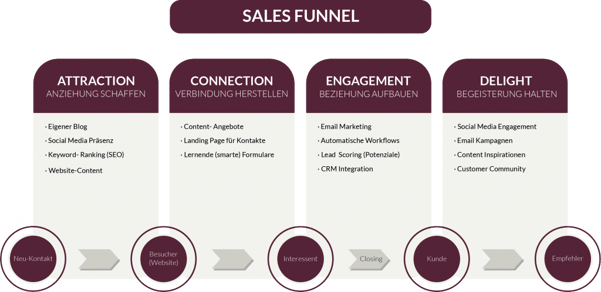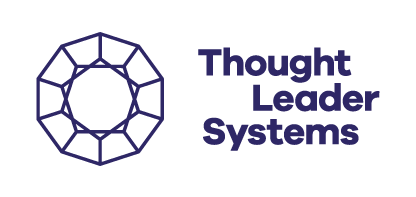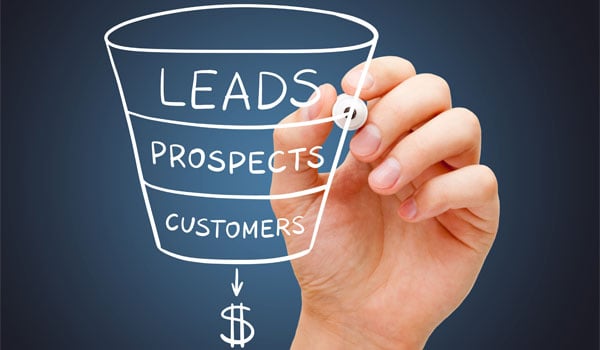Lead generation means acquiring new contacts and prospects. In online marketing, lead generation is a crucial part of the marketing job. Modern marketing concepts like inbound marketing heavily focus on generating leads through websites, social media, and proprietary platforms such as blogs.
The four steps to successful lead generation:
In lead generation, it is essential to focus on individual potential customers, as each buyer goes through their own unique information and decision-making process. New contacts with potential customers (prospects) arise all over the internet-on your website, on your blog, on your social media presence on Facebook and other platforms, and of course, through search engines like Google.

Lead management is the backbone of successful sales.
Inbound Phase 1: Creating Attraction
The first step in lead generation aims to attract new visitors (so-called traffic) to your website. But you don’t want just any visitors; you want the right ones. These are the individuals whom you can genuinely help solve their problems. These visitors have the potential to become customers.
-
Blogging: The foundation of inbound marketing is blogging. A blog is by far the best way to drive visitors to your website. To achieve this, you need to create informative and engaging content that resonates with your target customers and provides them with value.
-
Social Media Marketing: Share your content on social media, and engage with your contacts, prospects, and customers. Give your brand a human face on the web (Brand Face). Be active on the networks where your potential customers spend their time. This is effective social media marketing.
-
Keyword Ranking (SEO): Your potential customers start their buying decisions online. To gather information, they typically use a search engine. As an inbound marketing expert, you need to ensure that you rank prominently for relevant keywords—the search terms used by your customers. This requires careful and analytical keyword selection and providing content related to these keywords. Lead generation works only when you build relevance through keywords that are pertinent to your buyer personas.
-
Website Content: Optimize your website so that it speaks to your ideal customers and encourages them to get in touch. Transform your website into a valuable and interesting source of information. This makes your website a crucial part of your content marketing strategy.
Inbound Phase 2: Establishing (Connection)
Once visitors are on your website, the next goal of your lead generation is to convert these visitors into prospects. To further qualify a prospect, you need their contact details, at least an email address. Contact information is valuable in online marketing.
To encourage visitors to willingly provide this precious information, you need to offer something in return. This "payment" comes in the form of content offers like whitepapers, eBooks, tips, etc. The information should be valuable to your new contacts.
-
Landing Pages: For example, if a new contact downloads a whitepaper, they should be directed to a landing page. This is a specially designed web page where they provide their details to access the content offer. The sales team can use these details for lead generation and lead nurturing.
-
Smart Forms: To convert new contacts into identifiable prospects, they need to fill out and submit a form on the landing page. Optimize your web forms to make this process as simple as possible. Use smart forms that remember previously provided information, so the prospect does not have to re-enter it on their next visit. Instead, they can answer additional questions relevant to them.
Inbound-Phase 3: Beziehung aufbauen (Engagement)
What to Do When a New Contact Downloads a Whitepaper, Fills Out a Form, or Engages with You but is Not Yet Ready to Buy?
Here, email marketing becomes a crucial tool in your lead generation strategy. Send specifically designed emails with valuable and tailored content to continue building trust, enhance the relevance of your offer, and ultimately increase the likelihood of purchase.
-
Automated Workflows: Using your inbound marketing software, create communication sequences tailored to the prospect’s buying stage. Workflows help automate many communication processes, ensuring that prospects receive relevant content and follow-ups based on their engagement level.
-
Lead Scoring (Potential): You have the contacts, but how do you determine which of these prospects are ready for a sales conversation? By using numerical lead scoring, you can eliminate the guesswork and identify which leads are ripe for a discussion with your sales team.
-
CRM Integration: Link your CRM system with your inbound marketing software. This integration automatically tracks how new contacts progress along the customer journey. Modern inbound marketing software integrates with your CRM database, helping you manage sales workflows and ensure seamless coordination between marketing and sales efforts.
Inbound Phase 4: (Delight)
The core of lead generation lies in providing content that is perfectly suited to the needs of both prospects and existing customers. After a purchase, you certainly won't want to stop delighting customers with engaging content.
With inbound marketing, you strengthen customer loyalty, delight customers with helpful insights, and ensure that your customers happily recommend your brand and products. You can delight your customers using the following tools:
-
Social Media Engagement: Integrating your social media channels into your marketing automation software allows you to offer real-time customer service and support.
-
Email Campaigns: Continue providing your customers with exceptional content. Develop exclusive content offers just for customers, special promotions, and deals. Email remains a crucial component of inbound marketing as it is your direct line to your customers.
-
Content Inspiration: Expand your customers' knowledge and ensure optimal use of your products through additional content. With the help of your inbound marketing software, you can enhance your content marketing and create entire online courses or even a customer academy.
-
Customer Community: Support your customers in exchanging ideas with one another. Create a community platform for this purpose. Surprise them with extraordinary user group initiatives and customer events.
Conclusion
Lead generation is an effective methodology for acquiring new contacts and prospects on the internet. By following the four steps of lead generation, you can drive additional traffic to your website and encourage visitors to register as leads in exchange for valuable content. Support these new prospects in solving their problems. Maintain contact with them and assist them throughout their customer journey until they make a purchasing decision.


